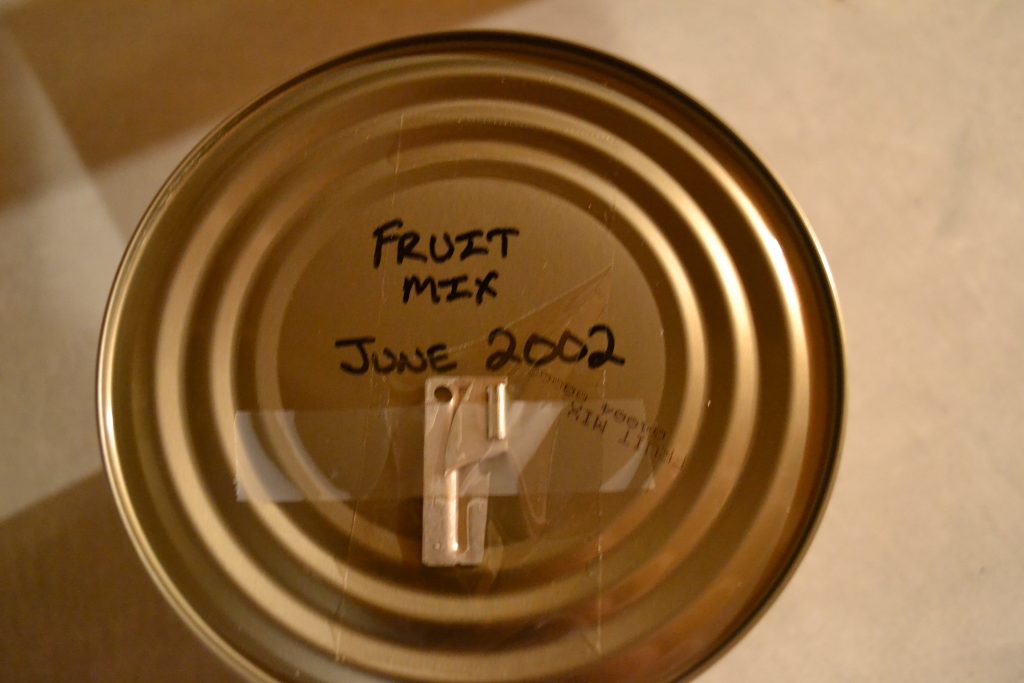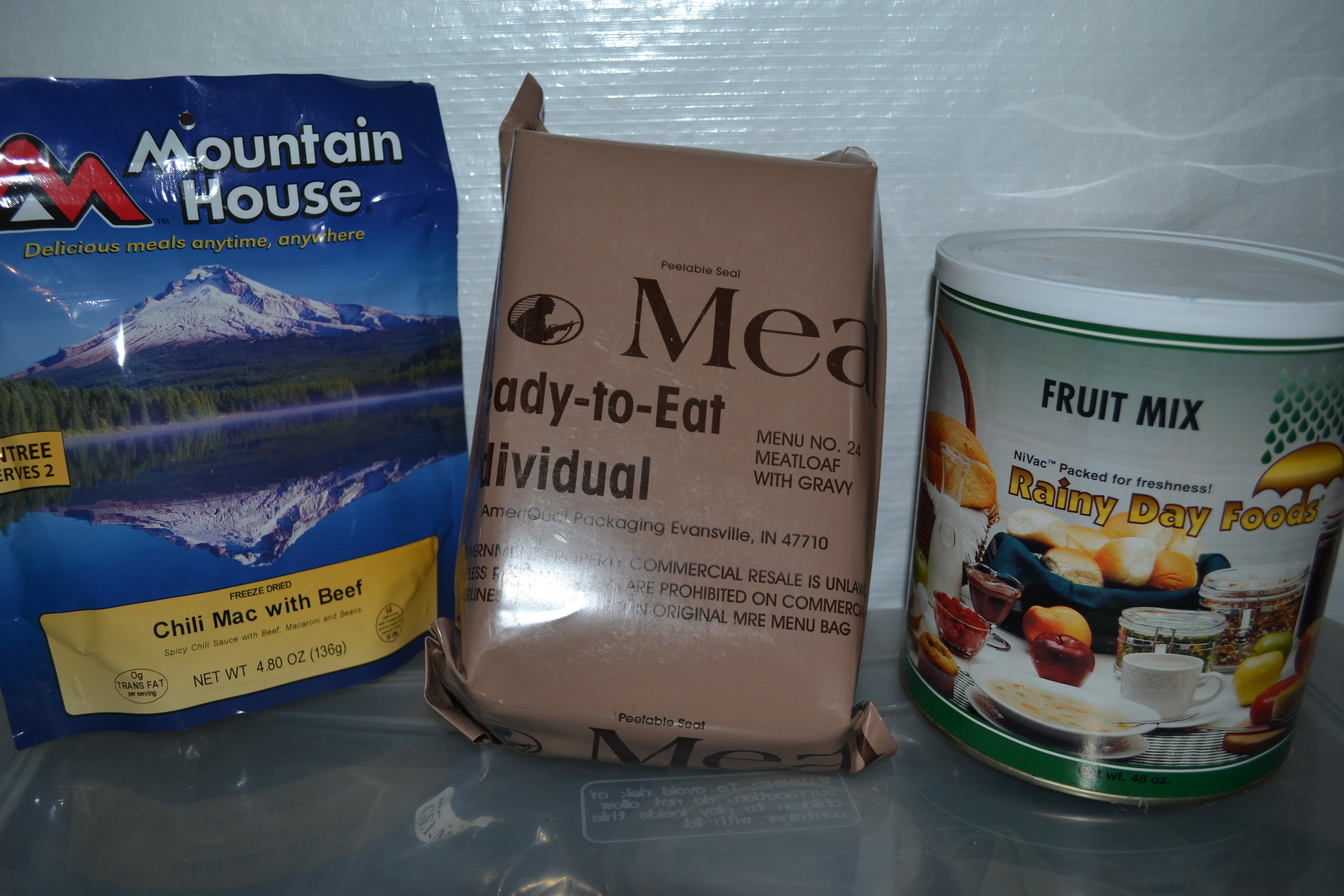“When the average American says, “I’m starving,” it is a prelude to a midnight raid on a well-stocked refrigerator or a sudden trip to the nearest fast food restaurant.” ―
Food storage has been a mainstream and absolutely necessary endeavor throughout recorded history. From the ancient Egyptians to the Founding Fathers, access to food during weather and war meant survival!
Well into the 20th Century our grandparents (and even some of our parents) regularly canned and stored food. Only recently has the “necessity” of food preparations fallen out of mainstream favor. What changed?
Mankind is only about 120 years (4-5 generations) removed from an agrarian lifestyle. 100+ years ago, nearly every family had a garden, and most had livestock (at least chickens), as not possessing their own means of food production would have meant certain demise. Having enough to eat was a struggle, and was what most of what one’s time and effort was devoted to. In the 1800’s, being fat was actually a sign of wealth – it indicated abundance – and still remains the case today in many countries around the globe. It’s the Western nations of Europe and North America that are wealthy enough to overeat.
Our abundance and relative peace (at home) has diverted our attention into areas that only peace and abundance can. E.g. appropriate pronoun usage and confusion about which bathroom to use. It WAS widely understood that crops fail, jobs are lost, and mother nature can go full honey badger without warning – and nothing about that has changed. This is what separates food preparation as a “duh, why not?” topic over that of solar energy, firearms, defense training, gold, communication, etc…
Hunger should sing a familiar song to all races, sexes, political ideologies (and perhaps even to those who think Epstein actually killed himself.) What is less understood is that war and civil unrest were at the core of our ancestors’ food preparation activities. Think for a moment how many news stories we see about someone being “outraged.” I wonder how many of these stories would make it into a tweet, let alone breaking news coverage if that person’s credit cards stopped working, the shelves were cleaned out at the grocery, and a group of nefarious characters (from another country or, most likely, another city) were kicking in their neighbor’s front door? We already know what they think is “outrageous” – what word might they use to describe an actual outrage? Actual outrages are not fantasy for many in this world, they are a daily occurrence.
Detachment from our food supply (and supply chain in general) is, in my opinion, going to be the single most damaging and immediate threat to civilization during a prolonged disruption of any kind. Having solar panels to charge your iPad, firearms to protect your home, and precious metals to preserve your wealth won’t matter when you’re starving. I often hear or read about people who believe their possession of firearms will enable them to just take the food they need. Setting aside morals and consequences of such a strategy, most of the people with the food worth risking one’s life to obtain are going to be well armed, well organized, and probably expecting you. (Ask us how we know.)
Food preparation is more important today than ever before – but, why?
To maintain inventory and keep up with demand, grocery stores in rural America get 7-10 deliveries per week. Grocery stores in urban and metropolitan America get 10-14 deliveries… per DAY. You read that correctly. This is an inventory supply chain methodology called Just-In-Time (JIT), and corresponds to an accounting methodology called First-In/First-Out (FIFO), which is largely employed due to expiration dates and rapid inventory cycle times.
Have you ever heard someone born before 1990 ask a store clerk if they could “check in the back for more?” Well, JIT generally did away with “the back” (warehouse portion) of most grocery stores. Retailers and markets used to have giant back rooms which contained nearly equal square footage as the anterior/showroom. The back areas were stacked with pallets of inventory (both dry and refrigerated) that would be used to restock the front as shelved products were depleted. At the time this meant more food was available locally to respond to sharp increases in demand. It required larger, but much less frequent deliveries, and generally meant less variety from a brand perspective.
Once JIT was implemented – a convenience made possible by the national highway/rail/air infrastructure and modern computing/database technology – stores were able to rely on historical analysis and predictive technologies to forecast inventory quantities and schedule deliveries on-demand. JIT enabled stores to dedicate more square footage to shelved inventory which meant they could carry a larger variety of “things” (turning markets into supermarkets). This is why we have 187 different brands of the same product in one aisle, and we find combination locks and canoes only a few aisles away from milk and eggs – Its wonderful! Seriously, this is a great modern convenience. But, to achieve it, stores must be efficient with every square inch of floor-space and dramatically increase the frequency of deliveries to stock their shelves. Today, “the back” is limited to primarily evening restock inventory and seasonal items. There is simply no way to realistically house the inventory necessary to maintain such product breadth and depth, long term, locally unless your store is the size of IKEA.
Fun Fact: Do you know what the #1 item is to disappear from Walmart shelves before a hurricane?
Answer: Cherry Pop Tarts.
Water is #2
Water is #2, c’mon? Are teenagers and potheads doing the shopping? Walmart boasts the most sophisticated JIT supply chain on the planet and their suppliers are encouraged (more like forced) to conform to their methods. Every time our country experiences a hurricane, the news distributes high definition video of Walmart store shelves – empty. There are a few takeaways here but the most concerning should be this: Walmart understands the demand – historically, predictably, consistently, and well in advance thanks to modern Doppler Radar – yet they still run out? (But, but, I was told those greedy corporations wanted to profit from my plight!?!) Now, imagine what would happen if the impact zone was more widespread, the disaster more complex, the citizenry more frightened, and the timeline more uncertain. Now stop imagining and understand that our global enemies already know this. America is strong, but our way of life is actually quite vulnerable. This is why most of them acknowledge American can only be destroyed from within. The only question left is: which one of them give it a push?
America has enjoyed, and will very likely continue to enjoy, the fruits and conveniences of cultural and technological innovation. From 1783 to present day, our oceanic moat, nuclear arsenal, and generally friendly national neighbors have proven to be sufficient for repelling/deterring foreign invaders – a luxury the rest of the world can only dream about. But, with that geographic isolation has come a degree of complacency – the attitude that “it can’t happen here…because it never has.” In reality, our domestic systems – financial, transit, power transmission, healthcare, consumer finance, education, internet, etc – are sensitive, complex, and interwoven. A significant disruption in any one of them will have (at best) an inconvenient ripple effect upon the rest. Small but public attacks on just a few, with the threat of more to come, might be all it takes for complete panic to occur. Or maybe another downturn in the economy? A cyber attack on our power grid? …Replacement components for such are manufactured overseas and require a 18-24-month lead time. What could possibly go wrong?
Having some food on hand is not only prudent, it’s among the easiest and most practical preparations to take. It’s also entirely within your control. The rest of the preps are important but unlike most of them, additional food is something you can use anytime, in public, no explanation needed and must have in order to live.
So, let’s run through some basics:
FOOD PREPARATION CONSIDERATIONS
Dehydrated: Dehydrated is exactly what it sounds like – most of the moisture, about 60-80% is extracted using a low heat. This heating process shrinks the product in size and adds to the shelf life. However, dehydration can result of some loss of flavor and a chewier product. Almost 100% of the products available in dehydrated form are singular – just strawberries, just bananas, or just potatoes. It is rare to find mixed foods and almost impossible to find full meals in dehydrated form because food products dehydrate inconsistently – some would burn before others would sufficiently dry. I know, I’ve tried it.
Freeze Dried: Freeze Dried is also what it sounds like but the process is a bit more manufactured than with dehydrated foods. The product is not just frozen, it’s flash frozen (rapidly) and a vacuum is used to extract something like 95-98% of the moisture. Size is similarly reduced as with dehydrated foods but no taste is lost as there is no heating involved in the process. Once complete, the product becomes dry, crunchy, and crummy. It’s this last descriptor that gives freeze dried a major advantage over dehydration. The freeze-drying process extracts so much moisture, you can actually dry liquids into powder form. This gives the consumer the ability to purchase entire meals / finished products like soups, pastas w/ sauce, and more complete/complex meals such as beef stroganoff or chicken and dumplings with vegetables. Once hot water is added and the product is reconstituted, it’s finished and ready to eat. Keep this fact in mind when I discuss Mountain House brand meals in a bit.
Dehydrated vs Freeze Dried:
The next question I get is which is better, Freeze Dried vs Dehydrated? Freeze Dried foods are specifically engineered for long term storage. Dehydrated foods are fun culinary gimmicks for parties, treats for kids, and work out junkies.
Serving Sizes
Servings are horribly misleading and represent a balance of two competing pieces of information 1) Regulatory brand labeling requirements for nutrition and 2) a brand’s marketing effort to consumers. In the mind of most American consumers, a serving is probably how much fits on their plate. But the serving on a nutrition label is very different and not a realistic suggestion of an individual’s meal portioning. I don’t know about you, but a what I consider a to be a serving differs greatly from my wife. Also, marketers are sly foxes when it comes to servings. For Pop Tarts – 1 pastry is considered a single serving, yet they are packaged in pairs. For Pringles Potato Chips, a single serving is 16 chips – who the hell eats only 16 Pringles? Right now, I dare you to eat 16 and say no to the 17th. Check the label on soups and other canned goods, though small, they actually contain multiple servings.
Calorie Source: Beware the 1-Year Supply
It is generally accepted that 2,000-2,500 calories per day is healthy. Yes, I know it depends on the composition of those calories, workout routine, and based on data from the 70’s but this isn’t an article about any of that. The 2,000 calorie marker is important because it is frequently used by storable food manufacturers to justify a “1 Year supply” of food. That caloric marker may be fine in “normal times” but you’ll need double or even triple the calorie count if you’re doing a lot of physical labor outside like planting a garden, running from zombies, or defending the homeland.
Most of the 1-Year Food Supplies contain a “nutritional drink” and it’s usually orange. This drink is marketed like Kool-Aid or Tang but tastes nothing like either. It does contain calories though which are part of the 2-2.5k calorie claim. The other problem is there is A LOT of this in many pre-packaged stocks. My Patriot Supply is guilty of this more than any other vendor out there. They actually have really good individual foods, but their convenience packs contain WAY more of this orange drink than consumers realize or will ever consume. Most suppliers are rarely questioned about this because 90+% of their customers have never opened that food pack to take inventory.
This is not the only example of calorie masking and we don’t have time to go through each one. But the orange drink example and the 2,000 calorie markers should be in your mind when selecting food for your family. You’re going to have to do some math beyond “the price is right” when selecting foods. You will need way more than 2,000 calories per person. As a benchmark, Michael Phelps consumed 12,000 calories per day and still looked like Michelangelo’s David. Bottom line: Caloric intake is more important than serving size. Buy and prepare assuming 3,500-4,000 calories per adult, per day – minimum!
Taste Test – Taste test, taste test, taste test! Tasting your stored foods is a task overlooked by everyone, including me. I bought a lot of food because it was marketed on websites that I frequented and I’m a big believer in supporting advertisers that keep your programs alive. My wife and I have enjoyed food from every vendor and had to spit some out from a couple. Heads up, it will all be salty, as that’s a necessary part of the preservation process. It’s hard to screw up freeze dried individual items like green beans, corn, and strawberries, but meals should be taste tested. By the way, have I mentioned it’s worth tasting your food – especially before buying a full year worth? You might want to taste it.
Such advice goes double for your children! Don’t think for a second they will eat anything they don’t like just because they are hungry – and, actually, neither will most adults. Of course, most of us won’t starve to death before we eat a brussel sprout, but not eating for days during a crisis isn’t good for anyone, either. We need vitamins, minerals, carbs, and proteins for our bodies and brains to function correctly. Disaster clean up and survival takes lots of calories – store food you LIKE, and store food your family LIKES. And the only way to find that out is to taste it.
WHERE TO START:
Canned Storage:
If freeze dried foods and long-term food storage are not your bag, that’s fine. As long as you’re organized, there is another way.
Every time you go to the store, buy a few more canned goods and dry pastas than you need.
This is the easiest activity to start and continue. Buy a couple cheap plastic bins at Walmart and store these goods under a bed or in a closet. Heat and moisture are the primary enemies of canned goods and pasta respectively. This is not necessarily the cheapest way, but it can be quite affordable. It is certainly the easiest to absorb. Increasing each grocery bill by $10-20 is easier on cashflow than a $3800 1 year supply of food from a specific vendor.
Stay organized. Mark them with duct tape and a sharpie for the date you bought them and the expiration date. On the expiration date, move the expired products into your pantry for short term use and replace the food stores with newly purchased items. This rotation is simple, but hard to remember.
Always look in the sale aisle, and don’t fear the dented can discount bin!
Ingredients:
For Ingredients and other staples like butter, cheese, specific stand-alone fruits and vegetables I advise going with Emergency Essentials or Thrive brands. Both are very good for each of these. My kids LOVE their freeze dried fruits and we give them baggies of them for snacks, no need to reconstitute.
Meats:
For high-end meats, I go to the Military Surplus section a www.mredepot.com
This site has a pretty decent variety of products but their military surplus freeze dried meat section is pretty comprehensive and changes regularly.
The meats in the military surplus section are overruns for US government agencies such as FEMA and various Continuity of Government locations like Cheyenne Mountain (former NORAD) and Site R (Raven Rock Mountain Complex). If Obama and Trump are eating this stuff, maybe we should have some too.
Shipping is fast. I’ve bought quite a bit variety from here but only tried their beef filet mignons and pork chops – both were very good. They have full meals as well as ding dongs and other deserts too – pretty interesting. MRE Depot sells Yoders canned bacon too, shorter shelf life (10yrs) compared to the typical 25-30 years, but everyone needs bacon. Food ingredients and other products are sold under the Future Essentials branding – quality – except for their pasta. I don’t think the pasta is worth the purchase here due to the sizing of the cans for the price. Watch for #10 cans vs #6 or #2.5 – smaller cans are not recommended unless portioning is a concern.
Which brings me to an interesting but risky consideration. Should the feces ever impact the oscillating device, consider making a list – a very, very short list of items that will be purchased at the last minute. Pasta is one of those things for our family. Its dirt cheap to buy at the store, we love it, and it keeps naturally for 2-4 years if stored in a cool dry environment. But we’ve found that pasta packaged for a 25-30 year shelf-life is really expensive.
Meals:
There are good things to be had at Numanna and My Patriot Supply as well as the others mentioned here – It’s been awhile since I ordered from either one, but we’ve been generally pleased. One company that is not mentioned here is eFoodsDirect – I was burned by them. Many of their meals were decent at the time, but after 5-7 years on the 25 year lifespan they have aged to be just “ok”, or flat out bad (bitter).
What I’ve been doing a lot of lately is buying full meals from Mountain House. These obviously present some distinct time-saving and convenience advantages but with that comes a higher cost. I purchase #10 cans in bulk (by the 6-can-pack) as well as Individual Pouches which are great for on-the-go. The pouches contain enough for any adult meal. Mountain House brands are available in a lot of different places but it seems Amazon and CostCo Online have some of the best deals and varieties. Both places make good recommendations if you search generically for Mountain House. If you don’t have a Costco membership, find a friend who does.
I did some math recently for some of the benefits you can get by going through CostCo’s Mountain House Variety Pack.
CostCo Mountain House Variety Pack (Individual Pouches): $489.
<<<VS>>>
Amazon Equivalent Prices by 6 pack of Individual Pouches:
- Beef Stroganoff 18 Pouches: $44.98 * 3-6packs = $135
- Spaghetti & Meat Sauce: $40 * 3-6packs = $126
- Chicken Noodle Casserole: $45 * 2-6packs = $90
- Chick Teriyaki: $42 * 2-6packs = $84
- Breakfast Skillet: 1 6pack = $42
- Biscuits Gravy: 1 6pack = $38
- Blueberry Granola = $28 * 3-6packs = $84
TOTAL = $598
At $489, Costco saves over $100 on this package deal.
Recommended Brands:
A few extra food storage tips:
1 – Using a Sharpie pen, mark every can on top and bottom with the contents and date purchased. Then, take clear packing tape and stick a piece over the writing. This is a back up in case the labels deteriorate or are damaged. The tape keeps the ink from being rubbed off.
Mark and date all boxes and packages – you will never be sorry you took the time to do it!
2 – Also tape a P-38 military can opener to each can – at least each large (#10) can. Such can openers may be purchased in lot of 50 or 100 for pennies each. Should you need to hand out food to others, or grab and go, you have an onboard opening system included!

P38 can opener taped to a #10 can of storage food. This can is being rotated out and replaced, but we will salvage the can opener and reuse it.
3 – The more advanced food storage enthusiast might find buying dried good in bulk and creating their own packaging to be more cost effective.
The Foodsaver brand vac-u-sealer is one way of packaging one’s own dehydrated fruits, etc., but it is quite time consuming.
A better way of storing bulk – and by bulk I’m talking 5 to 6-gallon pails – is as follows:
Purchase new, clean, buckets, as well as gasketed lids. They can be obtained from most building supply stores, like Menards or Lowes. They do not need to be “food grade” as the food will never be touching the insides.
Next, get a supply of bucket-size mylar bags. Available through Amazon and many “prepper” sites.
You will also need some sort of heat sealer for the bags. Those can range from small, hand-held, $8 junk, to commercial-grade “clam shell” sealers.
Lastly, to do it right, you will need a bottle of nitrogen, with a regulator, hose, and a 2” long piece of aluminum or copper tubing that can be adapted to the regulator hose. Nitrogen bottles are not licensed, and can be obtained from any welding supply house, as can the regulator and hose. Tubing = hardware store.
The process is simple – take a bucket, insert a bag. Fill the bag up with your choice of dry food product (Wheat kernels, rice, potato flakes, Bisquick, pancake mix, pasta, beans, etc…) ¾ up to the top of the bucket. Insert the nitrogen nozzle to the bottom of the bag and lightly crack open the regulator. Poke the nozzle around in different places – how many times and for how long depends on the density of the food product in the bag. You will feel a light breeze emanating, as what we are doing is evacuating the oxygen. Nitrogen is heavier than oxygen, and the two will not occupy the same space.
You won’t get all the oxygen out – and for that, you can add a couple of O2 absorbers, as well. O2 absorbers are small packets of iron oxide which will soak up the remaining oxygen. (The contents actually rust.) They are also available from most prepper websites, as well as on Amazon. (Pro tip – O2 absorbers come vacuum packed. If you buy a package of 50 make sure when you open them you will be using all 50. They will immediately start soaking up oxygen, and within a day or two they will be garbage.)
Once you remove the nozzle and throw in an oxygen absorber, seal the top. You’ll need to fold it in and get as much unused space taken up before you do. The reason the bucket was only filed up ¾ of the way is so you have room for the folded in bag.
Once the bag is sealed and secure, lock a lid on.
Lastly, mark all buckets on top, bottom, and side with contents and date. Tape over the writing with clear tape to protect the markings.
Grains and beans stored this way will easily last 20-years. Most likely much longer.
There are Youtube videos on this that will help you through the process.
Final notes:
– As mentioned above, keep all of your food storage dry and cool. Allowing canned goods (and really any long-term storage food) to heat above room temperature drastically reduces shelf life.
– Keep all of your food storage preparations SECRET! It’s no one’s business how much food you have at home. It’s no one’s business where you keep it or why you have it. If you think your family will blab about it, then they don’t need to know, either. False walls in crawl spaces can be arranged. Remember: When more than one person knows about something, it is no longer a secret!
– Rotate your storage food out regularly. What you don’t eat, donate to a food bank/local church. You can make sure your family’s crisis food is provided and help others. That’s a GREAT thing!
– Envy and Jealousy are killers. During a crisis, when your neighbors are losing weight and you’re not, there will be violence. My suggestion is to store far more food than you can personally use. This will allow you to play “good Samaritan” to your neighbors. Feeding them is a better solution than shooting them. Remember, no crisis lasts forever. Eventually order will be restored, and then we will all have to answer for our behavior. I’d like to be the one who behaved appropriately and doesn’t have to live in shame.
Conclusion
Life on planet Earth is fragile. It always has been.
We have conquered this planet like no other organism ever has; humanity has flourished. But, our survival is now dependent on technology. Technology that isn’t nearly as robust as the humans it serves, technology that is not fail-safe, and technology that is not secure. ….And with so many moving parts, there’s no way it can be.
Food is our Achilles heel.
“When disaster strikes, the time to prepare has passed.” – Steven Cyros







Leave A Comment
You must be logged in to post a comment.